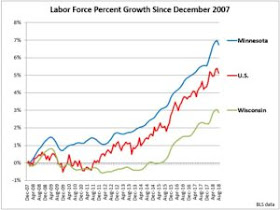The North Star analysis begins at the end 2007, where it notes both Wisconsin and Minnesota had the same 4.7% unemployment rate. Wisconsin suffered more damage than Minnesota did during the Great Recession, but kept its unemployment rate below the US average (and well below other Rust Belt manufacturing-heavy states like Michigan and Indiana). Once the Obama Recovery got going, logically Wisconsin had its unemployment rate fall more than Minnesota, as it was further away from full employment as the 2010s started.
The North Star Institute picks up the contrasts from there by reminding us how the unemployment rate is determined. As part of this, the "employment" figure the North Star Institute is using is the household survey of all individuals, and is in contrast to non-farm "jobs" numbers in that it captures people that work in all sectors (farm and non-farm), and credits a state with a person "employed" even if that resident works in another state.
The unemployment rate is equal to the number of unemployed people as a percentage of the entire labor force. In order to be part of the labor force, a person must be working or seeking work. (When a person stops seeking work, that person is no longer counted as unemployed or as a member of the labor force.) Whenever the percentage growth in employment exceeds the percentage growth in the labor force, the unemployment rate falls.
Thus, it is possible to have weak employment growth and still have a drop in the unemployment rate—provided that growth in the labor force is even weaker.
This has been the Wisconsin route. From December 2007 to August 2018, employment in Wisconsin has increased by 4.7%—well below the national growth rate of 6.3%. However, Wisconsin’s labor force growth has been even more anemic: 2.9% versus a national rate of 5.1%. The relatively weak job market in the Badger State likely discourages workers from looking for work, thus restricting growth in the labor force and lowering the unemployment rate not through job growth, but through frustration.
By comparison, higher-wage, less regressive Minnesota continues to attract workers and other individuals, which makes its sub-3.0% unemployment rate much more impressive. The differences in labor force also bear that out.
Minnesota, meanwhile, has achieved its low unemployment rate with job and labor force growth well above the national average. From December 2007 to August 2018, Minnesota’s employment and labor force increased by 8.8% and 6.7% respectively—both rates significantly above the national average and approximately double the Wisconsin growth rates.
And that trend has continued in the last year, as Minnesota has nearly doubled up Wisconsin for workers in both availability, and actual employment.
Since the previous North Star article was published last fall (based on October 2017 data), Minnesota’s employment and labor force have increased by 1.6% and 1.1% respectively, compared to 0.8% and 0.6% in Wisconsin.† Over this period, Minnesota has added nearly 1.9 jobs for every 1.0 in Wisconsin. The most recent Quarterly Census of Employment and Wages from the U.S. Bureau of Labor Statistics shows that Minnesota has surpassed Wisconsin in terms of the total number of jobs, despite the fact that Minnesota has over 200,000 fewer people.Along with Minnesota, I also want to compare Wisconsin’s record with another mid-size state that has a lot of natural beauty, one major metro area, a lot of snow and an unemployment rate just below 3% – Colorado.
To a significant extent, Wisconsin’s low unemployment rate is driven by a weak job market that discourages workers from entering or staying in the labor force. Meanwhile, in Minnesota the low unemployment rate results from strong labor force growth combined with even more robust growth in the number of jobs.
At the start of 2011, when Walker and Dem Governors Mark Dayton (Minnesota) and John Hickenlooper (Colorado) took over their respective states, Wisconsin had more people living and working in their state – and a lot more when compared to Colorado (whose unemployment rate was higher than Wisconsin’s at the time, at 8.8%).
Household employment, Jan 2011
Wis. 2,831,200
Minn 2,737,400
Col. 2,486,600
Population, 2011
Wis. 5,705,812
Minn 5,345,967
Col. 5,116,411
Move ahead to today, and that gap has closed. To the point that Colorado may pass Wisconsin by 2020 in both stats if the trend continues.
Household employment, Aug 2018
Wis. 3,083,200 (+252,000)
Minn 3,015,360 (+277,960)
Col. 3,000,250 (+515,650)
Population 2017
Wis. 5,795,483 (+89,671)
Minn 5,576,606 (+230,639)
Col. 5,607,154 (+490,743)
And the growth in the Labor Force over the same period also reflects these trends.
Change in Labor Force Jan 2011- Aug 2018
Wis. +99,540
Minn +163,715
Col. +364,600
Compared to Minnesota and (especially) Colorado, you can see that Wisconsin’s drop in unemployment has much less to do with having more people in the state working than it was due to growth in our population and labor force greatly being much slower than those other mid-size states.
So keep that in mind when hear Scott Walker and other Republicans claim that their policies are working in Wisconsin because unemployment is so low. A lot of that “credit” is because regressive Republicans are repelling people from wanting to live here, and it’s limiting the ability of Wisconsin’s economy to grow. And that won’t change until the leaders in the Wisconsin Capitol making policy are changed.



No comments:
Post a Comment